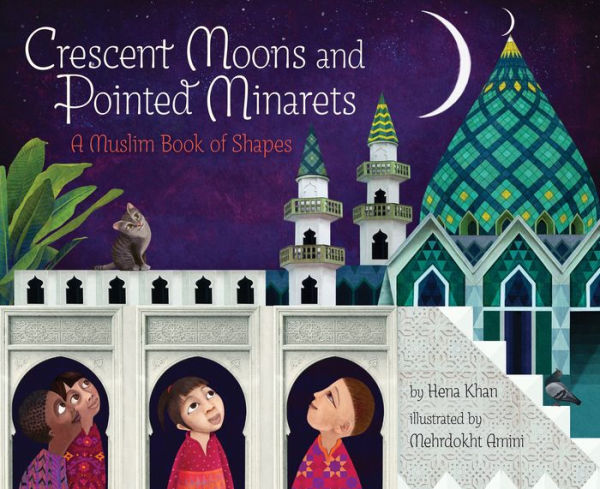
Crescent Moons and Pointed Minarets: A Muslim Book of Shapes
Written by Hena Khan
Illustrated by Mehrdokht Amini
Chronicle, 2018, np
ISBN: 978-1452155418
At a time when educators are sharing literature that increases children’s cultural competence, books like Crescent Moons and Pointed Minarets: A Muslim Book of Shapes are needed. This informative book captures home- and community-based religious practices, includes select Arabic words, and depicts Muslim culture in settings from around the world. It is also stunningly illustrated.
Hena Khan’s rhyming couplets provide a Muslim child’s view of shapes as they appear in daily life, annual religious holidays, and community events. “Rectangle is the/mosque’s carved wooden door,/filled with a pattern/that reaches the floor.” A number of the poetic lines include Arabic words, which further increases the authenticity of the information shared. “Circle is a daff,/a drum large and round./We fill the air/with its festive sound.” A glossary provides a pronunciation guide as well as definitions.
Author Hena Khan is a Pakistani-American Muslim woman who was born and raised in Maryland. She enjoys sharing and writing about her culture and religion (https://www.henakhan.com). Her Author’s Note at the end of the book includes information about the role shapes and geometry play in Islamic art and architecture. Since Islam forbids worshipping idols and discourages the use of human or animal forms in art, geometric patterns along with calligraphy and nature motifs predominate Islamic art.
The Author’s Note also says that artist Mehrdokht Amini depicted different Muslim traditions across countries in terms of art, architecture, and culture in each double-page spread. I emailed Amini to ask which countries were reflected in her artwork, and she responded immediately. The countries and cultural references she used in depicting each shape are (in order of their appearance in the book):
Cone – set in Malaysia;
Rectangle – set in Egypt;
Octagon – set in Afghanistan;
Triangle – set in Turkey;
Arch – set in Iran;
Cube – set in Saudi Arabia;
Square – set in Pakistan;
Circle – set in Kazakhstan;
Hexagon – set in Nigeria;
Oval – set in the Philippines;
Diamond – set in Mexico;
Crescent – set in the United Kingdom;
And the concluding page – set in Lebanon.
Including this information in the book would have been helpful for young readers (and educators) to emphasize that Muslim people live all around the world, with diverse local cultures and shared religious traditions.
Illustrator Mehrdokht Amini lives in Surrey, England. In addition to their cultural specificity, her illustrations sensitively capture her characters’ facial expressions as exemplified in another of her recent titles, Yo Soy Muslim: A Father’s Letter to His Daughter (Mark Gonzales, 2017). On her website, Mehrdokht Amini shares numerous examples of her artwork: https://www.myart2c.com/
Helping children increase their knowledge and further develop empathy as preparation for actively and effectively participating in a global community is a significant goal for educators and families. Crescent Moons and Pointed Minarets: A Muslim Book of Shapes is a beautiful book—both in print and illustration—that deserves a special place in classroom, school, and home libraries.
Educators can pair this book with this author and illustrator team’s prior collaboration: Golden Domes and Silver Lanterns: A Muslim Book of Colors (2015). Include both books in a text set focused on Muslim culture. For a focus on cultural competence and global citizenship, Chronicle Books published an annotated and illustrated of list of other books that could be paired with Crescent Moons and Pointed Minarets: https://www.chroniclebooks.com/blog/2018/08/01/6-books-teach-children-global-citizens/
A text set focused on art, shapes, and color would also be fun and informative for young learners. Round Is a Tortilla: A Book of Shapes (2015) written by Roseanne Greenfield Thong and illustrated by John Para and Green Is a Chile Pepper: A Book of Colors (2016) created by the same author and illustrator team would make thoughtful pairings. The former is available in a Spanish/English bilingual edition. These books, focused on Latinx culture, also offer rhyming text. John Para’s culturally authentic illustrations offer opportunities for comparison with Mehrdokht Amini’s art in Crescent Moons and Pointed Minarets.
Judi Moreillon, Literacies and Libraries Consultant, Tucson, Arizona
WOW Review, Volume XI, Issue 1 by Worlds of Words is licensed under a Creative Commons Attribution-NonCommercial-ShareAlike 4.0 International License.
Based on a work at http://wowlit.org/volume-xi-issue-1/
